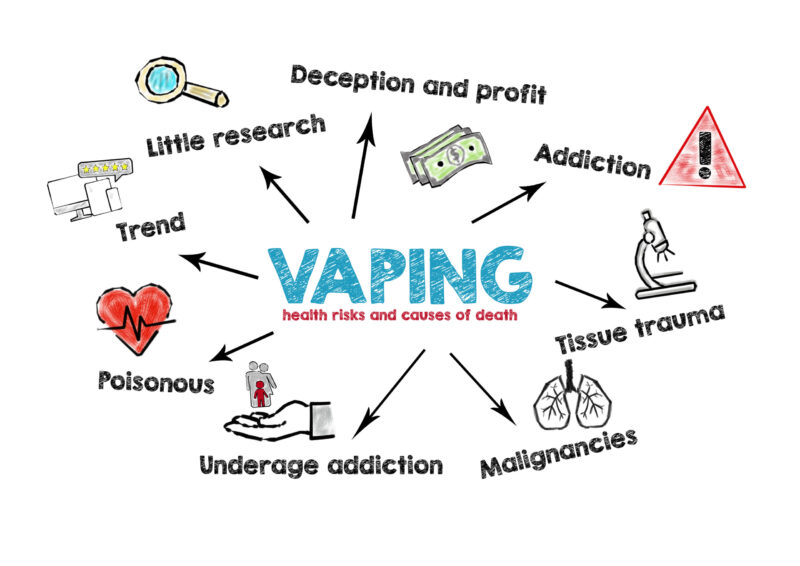The rise in youth vaping in the USA has sparked considerable concern among parents, educators, and policymakers. This trend is not merely a fleeting fad but a pressing public health issue that demands our attention.
Exploring the reasons behind the surge in vaping among adolescents and understanding its potential implications are crucial steps in addressing this challenge. By examining recent statistics, factors contributing to this increase, and the associated health risks, we can begin to formulate effective strategies to combat this issue.
Statistical Overview
Recent data reveal a worrying trend: an uptick in youth vaping across the United States. Comparisons with past trends show a significant shift. Just a few years ago, vaping was relatively unheard of among adolescents.
Today, it’s not uncommon to find E-cigarette devices in high schools and middle schools across the country. This sharp rise in popularity underscores the need for immediate action. Understanding these statistics is the first step in grappling with the vaping epidemic among the nation’s youth.
Factors Contributing to Youth Vaping

Several factors contribute to the rising trend of youth vaping. Marketing tactics by vaping companies play a significant role, employing flavors and branding that appeal to a younger audience.
Peer influence is another critical factor, as adolescents are more likely to adopt it if their friends do. The accessibility of E-cigarette products, including online sales that bypass age verification, exacerbates the issue. Innovations like the vape detector, as seen here, in schools highlight the challenge of controlling access to these products among minors.
Health Risks Associated with Youth Vaping
Vaping is not without its health risks, especially for adolescents. Research indicates that vaping can harm lung health, contribute to respiratory issues, and lay the groundwork for addiction.
Nicotine, a common ingredient in E-cigarette liquids, is particularly harmful to developing brains, potentially leading to long-term cognitive and behavioral issues. Understanding these risks is crucial for parents, educators, and policymakers aiming to protect young people from the adverse effects of E-cigarette use.
Regulation and Policy Efforts

In response to the youth E-cigarette use crisis, several regulations and policies have been implemented. These include age restrictions, flavor bans, and stricter marketing regulations aimed at making vaping products less accessible and less appealing to young people.
However, enforcing these regulations poses significant challenges, with many adolescents still finding ways to access vaping products. This ongoing struggle highlights the need for more effective strategies to curb youth E-cigarette use.
Role of Advertising and Marketing
Advertising and marketing strategies by vaping companies have a profound influence on youth perceptions and behaviors. These companies often deploy tactics targeting younger demographics, using social media, appealing flavors, and attractive packaging.
This targeted marketing has contributed significantly to the rise in vaping among adolescents, suggesting a need for stricter advertising regulations to protect young people from these influential messages.
Impact on School Environments

Youth vaping has a notable impact on school environments, affecting academic performance and student health. Many schools have reported an increase in vaping-related incidents, leading to disciplinary measures and the implementation of prevention programs.
The presence of E-cigarettes disrupts the learning environment and poses challenges for educators trying to maintain a healthy and productive school setting.
Social and Cultural Factors
Social and cultural norms play a significant role in shaping youth attitudes towards vaping. The portrayal of vaping in popular media often glamorizes the practice, influencing young people’s perceptions and making it appear more acceptable.
This cultural backdrop contributes to the normalization of E-cigarette use among adolescents, underscoring the importance of addressing these societal influences to change youth attitudes and behaviors.
Peer Influence and Peer Pressure
Peer groups have a considerable influence on youth vaping initiation and continuation. Adolescents are more likely to start vaping if they see their peers doing it, succumbing to peer pressure and the desire to fit in.
The role of social acceptance in these decisions cannot be overstated, making young individuals vulnerable to adopting harmful habits. Addressing this issue requires strategies that empower young people to resist peer pressure and make healthier choices.
This involves promoting environments where positive behaviors are celebrated, and E-cigarette use is not viewed as a ticket to social acceptance. Parents and educators play a pivotal role in fostering resilience and critical thinking among youth, equipping them with the skills to make informed decisions despite peer influences.
Public Health Interventions

Public health campaigns play a critical role in educating youth about the dangers of vaping. These interventions, including awareness programs and educational initiatives, aim to inform young people about the health risks associated with vaping.
Tailoring messages to resonate with the youth’s experiences and utilizing platforms where they are most active can enhance the effectiveness of these campaigns. Successful strategies have shown a positive impact on youth behavior, reducing its rates and encouraging healthier lifestyle choices among adolescents.
By leveraging social media, celebrities, and influencers who advocate for a vape-free lifestyle, public health interventions can achieve broader reach and deeper impact.
Parental Involvement and Education
Parental involvement is crucial in preventing youth vaping. Parents who are informed and engaged can significantly influence their children’s attitudes and behaviors. Beyond merely discussing the dangers of E-cigarette use, parents should strive to understand the pressures and challenges their children face that may lead them to vape.
Providing resources and tips for parents to discuss it with their children can empower families to address this issue effectively. Open communication, education, and setting a positive example are key strategies for parents looking to protect their children from the risks of vaping.
Demonstrating healthy coping mechanisms for stress and peer pressure, and establishing a trust-based relationship where children feel comfortable sharing their concerns, can significantly reduce the likelihood of E-cigarette use initiation.
Conclusion
The youth vaping trend in the USA presents a complex challenge that requires a multifaceted approach. From policymakers to educators, parents, and communities, a concerted effort is necessary to address this public health issue.
By understanding the factors contributing to the rise in youth vaping, the associated health risks, and the effectiveness of current interventions, we can work towards developing more effective strategies to protect our young people from the harmful effects of vaping.
The fight against youth E-cigarette use is ongoing, and continued vigilance and action are essential to safeguard the health and well-being of future generations.



